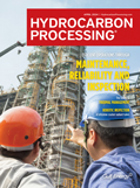Catalysts
Revamp results for CCR catalytic reforming unit with atmospheric regenerator
The reformate market is changing.
Onsite
Jenny Hebert and George Yaluris of Albemarle accept the <i>HP</i> Award for Best Catalyst Technology.
More residue processing in FCCUs
Resid units have more than 2 wt% Conradson carbon residue (Concarbon) in feed and more than 5,000 parts per million (ppm) of nickel (Ni) and vanadium (V) on equilibrium catalysts (Ecat).
Hydrocarbon Processing Awards
<i>Hydrocarbon Processing,</i> the downstream processing sector’s leading technical publication, has announced the winners for its second annual awards.
Viva Energy’s Geelong refinery reduces FCCU turnaround risk
Change involves risk. Many fluidized catalytic cracking units (FCCUs) can be operated more profitably, but changes to achieve more efficient operations can be risky.
Reduce dry gas and coke with a more flexible FCC technology
To meet increasingly stringent specifications for cleaner gasoline and to produce more clean fluid catalytic cracking (FCC) naphtha with lower olefins, a novel FCC technologya for maximizing isoparaffins was developed in the late 1990s. The technology’s principal is based on the formation and conversion of olefins in two different reaction zones.
Additive solutions to SOx emissions in FCCUs
Sulfur oxide additives are typically based on hydrotalcite or magnesium aluminate spinel-type structures. Magnesium alumina is the pickup agent present in the most effective SO<sub>x</sub> additives on the market; therefore, to optimize SO<sub>x</sub> reduction, it is critical to maximize the amount of the critical magnesium component in the fluid catalytic cracking unit (FCCU) in an efficient and cost-effective way.
Editorial Comment: Celebrating the latest advancements in HPI technology
At the end of this month, <i>Hydrocarbon Processing</i> will honor the latest technological advances in the hydrocarbon processing industry (HPI) at an awards gala.
Hydrocarbon Processing Awards
<i>Hydrocarbon Processing</i>, the downstream processing sector’s leading technical publication, has announced the finalists for its second annual awards.

- Vertex Energy pauses renewable diesel output to switch back to fossil fuels, citing macroeconomic woes 5/10
- Citgo Petroleum reports Q1 profit of $410 MM 5/10
- Golden Pass LNG in discussions with contractor, may delay startup 5/10
- SAFFiRE Renewables biofuel pilot plant to be developed in Kansas 5/10
- EBRD backs Ukraine's green biofuels project with €60-MM loan 5/10
- Russia's refined oil product exports to Singapore to hit highest this year in May 5/10




